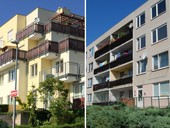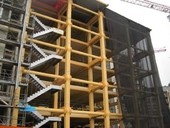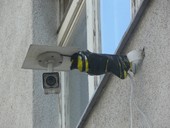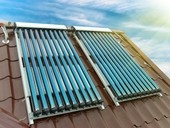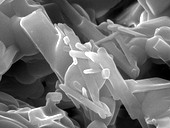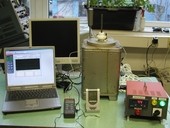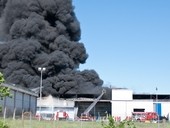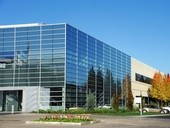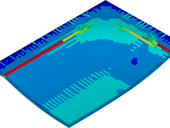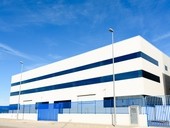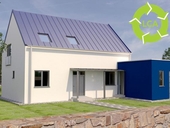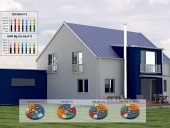Assessing energy performance of the building is also done from the point of view of the need for non-renewable primary energy. A common layman probably does not know what this means. At the same time, the need for non-renewable primary energy fundamentally influences the design of energy sources for heating, cooling, hot water preparation, etc. for a particular building. The need for non-renewable primary energy is one of the three main energy performance indicators of a building, and if it is assessed as too large, the building can not be validated.
Archiv článků od 27.3.2017 do 30.10.2017
This study investigates the impact of energy renovation on the indoor air quality of apartment building during heating season. The study was performed in one residential building before and after its renovation. Energy audit was performed and energy certificate was calculated for the renovated and the non renovated condition of the dwelling. Objective measurements of CO2 concentration have been used for the evaluation. The average concentrations was much higher after the refurbishment. The air exchange rate was calculated, which was higher in the unrenovated apartments. This study shows that energy renovation of the residential buildings in Slovakia may reduce the quality of the indoor environment in the apartments especially in winter season.
Maintaining a healthy indoor environment requires much more intense air exchange after the reconstruction of the house as it is achieved. Although this is related to energy consumption, it is otherwise endangered by the health of the user. Reducing the thermal energy consumption of the house to the detriment of the quality of the indoor environment and the health of the users of the dwellings can not therefore be considered as a saving and can not be calculated when assessing the energy savings of the building's heating system after reconstruction.
The definition of what is a common part of a residential building is essential especially when modifying the building structures and eliminating defects that affect both a common part and residential units. How common parts are defined affects who finances the modifications and reconstructions of such structures and parts. The definition of common parts is based on the new Civil Code (No. 89/2012 Coll.) and on the already abolished Act on Ownership of Housing (No. 72/1994 Coll.).
At present, there is growing interest in the realization of multi-storey wooden buildings. In the case of multi-storey wooden buildings, their safety, stiffness and acoustics are of key importance. The submitted paper focuses on the issue of fire safety of multi-storey wooden buildings, which is currently the subject of major discussions.
For individual payment calculation for hot water we need an invoice from heat supplier with the total cost of the property in CZK and with the amount of GJ. In addition, we need the water supplier invoice, which includes the total cost of water and sewerage. For the calculation then we need water consumption from water meters.
The article presents research into the effect of carbon nanotubes in the blended polymer-silicate matrix containing raw materials from alternative sources. The intention was testing of several variations of mixture composition at the laboratory and also extreme temperature ambient. Assessing the suitability of the matrix composition was carried out by using both basic physico-mechanical parameters and then microstructural analysis methods (on selected samples).
The paper describes briefly the problems of temperature measurements during fire tests. To verify the standard requirement an experiment was conducted with three K type thermocouples (TC) of different diameters of wires and lengths of connected cables. TCs were inserted gradually into the el. heating furnace heated at the temperature of 800 ° C with records over time until reaching maximal steady state temperature; TCs were subsequently removed from the furnace and again with recording temperatures during cooling to the room temperature. The results are shown in the table and graphs. The experiments have confirmed that the sensitivity /response of TC to fluctuating temperatures of the gaseous medium depends on the diameter of the TC. It is obvious that these findings could have practical use in the field of fire protection.
Mandatory standard of building design – nearly energy zero starts for larger industrial buildings from 1st January 2018. This will have a major impact, especially in the design of the building envelope. This article analyzes whether the current setting of requirements of this building standard is technically and economically achievable. Analysis is based on typical industrial building.
This paper describes extinguishing experiments to verify the possibility of increasing the efficiency of extinguishing low, medium and high pressure water mist charging by the electric field of high DC voltage. The experimental results confirmed the effects of the electrical voltage, the configuration of electrodes (anode, cathode), the volumetric water flow rate, water pressure and the type of mist nozzle. Higher extinguishing effect electrically charged water mist to extinguish showed a shorter times to extinguishment, a smaller volume of water to extinguish the fire and extinguishing a higher percentage of successful attempts. Benefit: faster and more efficient fire- fighting with less risk of injury and less consequential damages in a protected space.
Design of building envelope, that means layers of so called boundary constructions; is the key procedure within the design process. It might seem that this step is crucial only for industrial buildings with low-energy ambitions or those that are intended for international environmental certification. This article is focusing on valid Czech legal requirements and also on the coming nearly energy zero standard of buildings.
This report presents a new method for designing composite timber steel-fibre-reinforced concrete slabs with unprotected secondary timber beams subject to fire, taking tensile membrane action into account. The FE-model consists of material tests, push-out shear tests and beam tests, which had formed a preliminary study. The FE-model represents the behaviour of the floor slab tested in experiment, together with a collapse prediction for the slab. The FE-model with characteristic material properties includes a safety concept based on the Eurocode standards, and is applied to define the fire resistance of various types of timber steel fibre-reinforced concrete flooring.
Energy efficiency of industrial buildings in not very common topic. However, the quality of design must be based on valid national legislation and technical standards. Task to achieve best energy ratings is more and more frequently laid on building designer and energy specialist directly from investor – developer.
This two-part paper deals with the topic of environmental effectiveness of buildings. The goal of the paper is evaluation of expected embodied environmental impacts related with a detached family house. First part of the paper describes the evaluated building and used methods. Seven currently common variants of load-bearing structures (walls and floors) are described and compared. Five variants include masonry, while the sixth and seventh variant includes cast-in-place reinforced concrete structures. The evaluation follows Life-Cycle Assessment (LCA) methodology according to ČSN EN 15978 standard. The results of the evaluation are shown in the second part of the paper. Under the specified boundary conditions the variant with ceramic masonry filled with mineral wool has 5–14 % lower environmental impacts than other evaluated variants.
This two-part paper deals with the topic of environmental effectiveness of buildings. The goal of the paper is evaluation of expected embodied environmental impacts related with a detached family house. First part of the paper describes the evaluated building and used methods. Seven currently common variants of load-bearing structures (walls and floors) are described and compared. Five variants include masonry, while the sixth and seventh variant includes cast-in-place reinforced concrete structures. The evaluation follows Life-Cycle Assessment (LCA) methodology according to ČSN EN 15978 standard. The results of the evaluation are shown in the second part of the paper. Under the specified boundary conditions the variant with ceramic masonry filled with mineral wool has 5–14 % lower environmental impacts than other evaluated variants.
zpět na aktuální články




